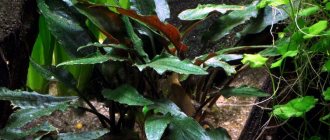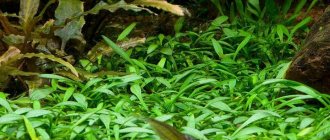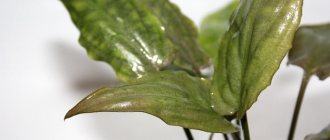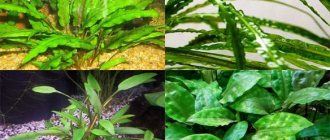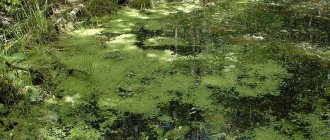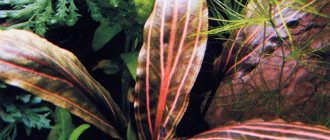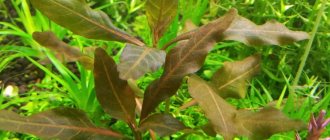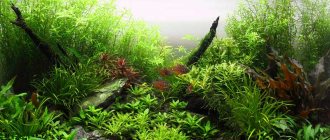Conditions
Temperatures for growing Cryptocoryne related can vary widely from 20 to 28 °C. At temperatures below 20° C, its growth slows down.
Cryptocoryne develops well only in water of medium hardness, from 8 to 20°. It is preferable to use water with a slightly alkaline pH reaction. The plant feels good in old and soft water, although with a sudden water change it can lose all its leaves. Regular water changes of 30-40% of the aquarium should be done when cryptocoryne is contained in hard water. However, even in soft water, excessive stagnation of water is not desirable, since this generally negatively affects the biotope.
Cryptocoryne related is undemanding to lighting conditions. In a shaded aquarium, it will continue to grow and develop, but this will noticeably affect its appearance: the characteristic foliage pattern is lost, the plant fades and fades. For artificial lighting, you can use fluorescent lamps of the LB type, the power of which should be at least 0.3-0.4 W per 1 liter of volume. Using incandescent lamps will enhance the red tint of the leaves. Natural sunlight also has a positive effect on foliage color. Cryptocoryne yellow loves long daylight hours - at least 12 hours.
Propagated by layering , which can be separated after the formation of several leaves 4-5 cm long, cutting the creeping shoot on which they were formed.
To speed up the reproduction of especially slow-growing species (for example, Beckett's cryptocoryne, reverse helix, undulata), you can try the following method. All leaves are removed from the rhizome of the plant and allowed to float on the surface of the water. After 1-3 weeks, often simultaneously, daughter plants form on it. When they grow several leaves 4-5 cm long, the rhizome is cut and the plants are planted in the ground. If only one plant has formed, then it is separated with a small piece of rhizome, and the remaining part of the rhizome is left to float until the next daughter plant is formed.
N. Jacobson (40) recommends obtaining Cryptocoryne flowering in the following way. The plant is planted in a flower pot about 7 cm in diameter with soil, the bottom layer of which consists of weathered granite with an admixture of quartz sand and the addition of fertilizer or from lime-free garden soil without humus. The addition of a small amount of peat is useful. A layer of gravel on top. The pot is placed on the soil of the aquarium, filled with water to a height of 2-4 cm. The soil is heated with a bottom heater. Fluorescent lamps are attached to the lid of the aquarium; the lighting duration is 12 hours per day. After six months or a year, most cryptocorynes begin to bloom.
Maintenance and breeding of Cryptocoryne related
Photo: Cryptocoryne affinis or Cryptocoryne haerteliana
Photo: Cryptocoryne affinis or Cryptocoryne haerteliana
Photo: Cryptocoryne affinis or Cryptocoryne haerteliana
Homeland - Malaysia. One of the most common among aquarists is cryptocoryne. It is very popular due to the beautiful color of the leaves - longitudinally striped, dark green above and burgundy-purple below, as well as the ability to grow in a wide variety of conditions. It forms dense thickets up to 30-35 cm high. The plant should be placed in the middle ground and near the side walls of the aquarium. The temperature when growing this cryptocoryne can fluctuate within a fairly wide range - from 20 to 28 ° C. At temperatures below 20 °C, growth slows down significantly. Cryptocoryne develops well only in water of medium hardness, from 8 to 20°, with a slightly alkaline or neutral reaction (pH 7-8). The plant feels good in soft, old water, but during the next water change or cleaning of the aquarium, Cryptocoryne often drops all its leaves. Regular water changes (1/5-1/4 of the aquarium volume) should be done when cryptocoryne is contained in relatively hard water. In an aquarium with soft water, it is better to only add water to replace the evaporated water. Cryptocoryne is undemanding to lighting. Long-term shading does not damage it, but the brightness of the color of its leaves depends on the intensity and duration of illumination. With a lack of light, the striped pattern of the leaves is lost, the purple color of their undersides disappears, and the plant acquires a faded green color. For artificial lighting, you can use fluorescent lamps of the LB type, the power of which should be at least 0.3-0.4 W per 1 liter of volume. Illumination with incandescent lamps enhances the red color of the leaves. Natural light, especially sunlight, significantly improves the appearance of the plant. The duration of daylight should be at least 12 hours. For good growth of Cryptocoryne, soil silt is very important. In poor soil, the plant develops very slowly and does not reach significant sizes. The size of the substrate particles is not significant. It is better not to use very large pebbles, since in a coarse substrate the basal shoots develop at a very close distance from the mother plant and begin to interfere with each other. When planting in new soil, lumps of clay or a mixture of clay and peat should be placed under the roots. The soil should be laid in a layer no thinner than 5 cm. Mineral fertilizing in well-silted soil does not have a significant effect on plant growth. If dense thickets of cryptocoryne form in the aquarium, the natural nutrients in the soil may not be enough. Then you will need regular, preferably weekly, fertilizing with complex mineral fertilizers, the basis of which should be nitrogen and microelements. Under artificial conditions, Cryptocoryne related reproduces only vegetatively. Young plants with 3-4 leaves are separated from the thicket that forms around the mother plant and transferred to a new place. In a humid greenhouse, the plant develops somewhat better than in an aquarium. To grow in a paludarium, you need nutritious soil, a temperature of at least 26 °C, and bright light. The terrestrial form of Cryptocoryne is less beautiful than its aquatic form, grown under favorable conditions.
Peculiarities
This species is also suitable for breeding in a paludarium or wet greenhouse; it is even somewhat simpler - it only requires nutritious soil, a temperature of 26 °C and good lighting. However, the shape and color of the leaves of the terrestrial form of this plant cannot be compared with its underwater variety, kept in good conditions.
It is extremely rare, only under extremely favorable conditions, to observe the flowering of this plant. Moreover, it is capable of blooming both on land and under water. The plant produces a long, spirally twisted peduncle, usually reddish-brown in color, with a closed flower.
Other species of the genus Cryptocoryne
- Cryptocoryne Balance
- Cryptocoryne Beckett
- Cryptocoryne Blassa
- Cryptocoryne Wendt
- Griffith's Cryptocoryne
- Cryptocoryne Neville
- Cryptocoryne Poetsch
- Cryptocoryne aponogenolifolia
- Cryptocoryne splendor
- Cryptocoryne yellow
- Cryptocoryne reverse spiral
- Cryptocoryne pontederifolia
- Cryptocoryne purpurea or red-flowered
- Cryptocoryne ciliata or Cryptocoryne ciliata
- Cryptocoryne cordata or Cryptocoryne cordata
- Cryptocoryne siamese
- Cryptocoryne ligulate
Priming
The main criterion for good growth of Cryptocoryne yellow is the siltation of the soil. In poor soil, the plant develops slowly and does not reach the specified size. When planting in new soil, lumps of clay or a mixture of clay and peat should be placed under the roots.
Coarse sand or small pebbles are suitable as a substrate; It is recommended to avoid the use of large pebbles, since basal suckers developing close to the mother plant can interfere with its growth. The soil must be laid in a large layer of at least 5 cm. Growth is well influenced by mineral fertilizing of cryptocoryne, the basis of which should be nitrogen and microelements. However, in well-silted soil, additional fertilizing is usually not required.
It is important to note that the soil should not bubble - in highly acidic soil, the roots of Cryptocoryne yellows die off. Periodically twitching the Cryptocoryne rosette a couple of centimeters and loosening the soil has a good effect on the root system.
Habitat and description
The natural habitat for Cryptocoryne Affinis is the wetlands of the Malay Islands and Southeast Asia. The variety is viable both underwater and on land.
In nature, herbaceous bushes grow up to 35-40 cm in height and form dense thickets in sand or gravel soil. Depending on the light intensity in the aquarium, they reach 10-35 cm.
Lanceolate, pointed leaves change their texture, size and color depending on the conditions. There are leaves painted on the outside in a light green color with a mustard tint or in a dark swamp shade; on the inside, the palette changes from emerald to dark cherry color. The veins on the leaves stand out clearly. The bush grows slowly and has no stems. The foliage is collected in a rosette and develops from the roots.
A characteristic but rare feature of Cryptocoryne Affinis is the production of an inflorescence. A long purple arrow (up to 20 cm), twisted into a spiral, grows from the base. The dark flower has a delicate scent.
Plants grown in greenhouses and paludariums are inferior to aquatic specimens in brightness and color range.
Fertilizer
Like any other plant, cryptocoryne needs nutrition for enhanced growth. Aquarists advise using solid fertilizers that can easily be placed in the soil. Their peculiarity is that they do not dissolve in water and do not pollute it.
In some situations, it is possible to use liquid fertilizer solutions. The main thing is that they are based on distilled water. Macro and microelements are dissolved inside, useful not only for plants, but also for all inhabitants of the aquarium.
Cryptocoryne Neville
Cryptocoryne Neville is a low-growing plant that is very resistant to any changes in the external environment.
Genus: Cryptocoryne
Family: Araceae
Habitat: marshy ponds of the island of Sri Lanka.
Appearance: the plant is a representative of low-growing forms of cryptocorynes, its height does not exceed 20 cm. There are varieties with wide and narrow leaves. The foliage of Cryptocoryne Neuville is round at the base and slightly pointed at the top, up to 6 cm long. On the outside the leaf is brighter, rich green in color, and on the inside it is pale green. The leaf blade is slightly shorter than the stem. The leaves are smooth and hard.
Root system: very well developed. The roots of the plant are white, fleshy, knotty, fragile, but strong. If desired, you can very carefully pull the cryptocoryne and pull it out of the soil with the root intact.
Soil: clay or peat. Soil thickness is up to 5 cm. With a lack of nutrients, plant growth slows down.
Lighting: diffused, partial shade.
Water parameters:
Comfortable temperature: 22-30°C.
“Acidity” Ph: 7-8.
Hardness dH: no more than 12°.
Aquarium Placement: Ideal for the foreground.
Reproduction: vegetative, root layering. The reproduction process occurs slowly, as does the development of the plant itself.
Botanical description
Cryptocorynes are small amphibious herbaceous plants found in terrestrial, semi-submersible and floating forms. They usually appear as a bush of 5-15 whole, petiolate, ovate or lanceolate leaves. In submerged cryptocorynes they are often ribbon-shaped with a pimpled surface. The color of the leaf blades can be olive, green, brownish, and sometimes bright red. The rhizome of Cryptocoryne is located horizontally. Small inflorescences are wrapped in a bizarrely colored blanket, transformed into a tube with a slightly swollen lower part. Inside the spathe there is a spadix 1 to 3 cm long - an inflorescence characteristic of aroid plants. The spadix consists of male and female flowers. The fruit of Cryptocoryne is a juicy berry.
Reproduction of Cryptocoryne in an aquarium
In a home aquarium, Cryptocoryne algae reproduce by shoots from the root. The seed method is practically excluded, because the plant blooms extremely rarely in an artificial reservoir.
On a creeping rhizome, a young shoot grows independently. After some time (quite a long time), the daughter shoot develops a rosette and its own root system. When the height of the small cryptocoryne reaches half the mother's height, it can be carefully separated and transplanted to a separate place.
The process is not so complicated, but it requires providing favorable living conditions for the plant and patience from the breeder. You should not prematurely take away the daughter’s young shoot from the “mother”. Not fully developed, he will still die.
Cryptocoryne Wendt
Cryptocoryne Wendt is a beautiful ornamental plant that is also easy to care for. It is often preferred by both professional aquarists and beginners.
Genus: Cryptocoryne.
Family: Araceae.
Habitat: fast-flowing rivers of Sri Lanka, found in swampy areas. Grows well both on land and under water.
Subspecies and appearance: there are 4 subspecies, the most common are Cryptocoryne Vendta Wendta and Cryptocoryne Wendta brown. The first has the appearance of a herbaceous bush with long leaves in the form of a rosette of olive or dark green color, without a stem. The second one is brown and has longer leaves. The height of the bush is 25-30 cm.
Root system: creeping, long rhizome.
Soil: loose, nutritious, soil grains ranging in size from 2 to 4 mm. Due to the well-developed root system of the plant, the thickness of the soil should be about 5-7 cm. If the soil in the aquarium is sufficiently silted with organic residues, then additional feeding is not needed.
Lighting: diffused, partial shade. Cryptocoryne Wendt does not like bright, abundant lighting; it feels comfortable in the shade of other aquarium plants, and this does not affect the color of the leaves. The length of the day is 12 hours.
Water parameters:
Comfortable temperature: 24-28°C.
“Acidity” Ph: 6.5-7.4.
Hardness dH: medium, 4-10°.
Cryptocoryne Wendta feels good in both old and newly added water.
Placement in an aquarium: the plant can be grown in aquariums of any size. Just remember that in a small reservoir it cannot be grown to the same size as in its natural habitat or a large aquarium. Cryptocoryne Wendt forms dense thickets, so it would look good in the middle of a large aquarium.
Reproduction: vegetative, root layering.
Why isn't it growing?
Cryptocoryne is a plant that grows incredibly slowly. However, if a plant lives for years and does not grow, this means that some characteristics are not conducive to the process.
It is necessary to determine the variety of cryptocoryne, study the parameters of hardness, acidity, temperature and light, which are required for active growth and development. Compare with those available in the aquarium. In order to provoke a growth spurt, it is enough to increase the temperature by a few degrees.
Cryptocoryne Beckett
A beautiful ornamental plant in addition to relatively uncomplicated maintenance conditions. Its leaves are compactly collected in a rosette and have different colors on both sides. Cryptocoryne Beckett is a low plant (up to 12 cm), so it is perfect as a decoration for the foreground and middle ground of an aquarium, forming small thickets. The plant goes well with any aquarium plants.
Genus: Cryptocoryne.
Family: Araceae.
Habitat: marshy ponds of the island of Sri Lanka.
Appearance: herbaceous bush, the stem is not pronounced. The leaves are in the form of a rosette, on low petioles that grow immediately from the root. The leaf shape is heart-shaped. The outer side of the leaf blade is soft olive in color, the inner side is red-brown. In an aquarium, the plant grows no more than 12 cm. The flowers are pale yellow.
Soil: nutritious. Substrate - coarse river sand and/or small pebbles. Before planting, a mixture of boiled peat, clay and charcoal must be added to the bottom of the planting hole. An alternative could be garden soil. The soil should be laid 5-8 cm thick. The plant can be planted in a clay pot and then placed on the bottom of the aquarium, camouflaged in a suitable place. Cryptocoryne does not require regular fertilization.
Lighting: average, direct sunlight is not allowed. If the aquarium lighting is bright, Cryptocoryne Beckett should be hidden in the shade of taller plants. Fluorescent lamps are preferable. The duration of daylight is at least 12 hours.
Water parameters:
Comfortable temperature: 24-28 °C. The plant will be able to withstand temperatures dropping to 20-22 °C, but its growth will slow down significantly.
“Acidity” Ph: neutral or slightly alkaline Ph 7.0-7.5.
Hardness dH: average 8-16 dH.
When water hardness and acidity decrease, “cryptocoryne disease” can develop. A change in these parameters can occur as a result of changing or adding water, so they must be adjusted in advance.
Placement in an aquarium: a tropical aquarium with a volume of over 40 liters is suitable. Cryptocoryne Beckett looks good in the front or center of the aquarium, next to various driftwood and decorative roots.
Reproduction: vegetative, root layering.
Pests and diseases
Diseases and their treatment
Cryptocorynes react poorly to any innovation: a change of location, a sudden change in lighting, temperature or water composition. This can cause them to get sick with “cryptocoryne disease,” which is accompanied by a loss of decorative qualities and then the death of the plant: the leaves of cryptocoryne become soft, turn glassy and begin to decompose.
It is still not known for certain what exactly causes cryptocoryne disease.
Sometimes the infection enters the aquarium with new plants affected by the disease. If the leaves begin to rot, try to save at least the rhizome: change the water and soil in the aquarium.
In the photo: Growing Cryptocoryne not in an aquarium
With improper maintenance and rare changes of water, Cryptocoryne is affected by root rot. You can save the plant at an early stage of the disease by cutting out all rotten and suspicious areas on the rhizome with a sharp sterile instrument.
If the plant is kept under too much light, it will begin to grow algae.
Elongated petioles and unhealthy pallor of the leaves are evidence of insufficient lighting, and if the leaf blades have become too light, this is a sign of a lack of nutrients in the soil. In low-temperature water, the growth and development of cryptocoryne stops.
- How to fertilize flowers
Pests and their control
Cryptocoryne can be damaged by snails. Just remove them from the aquarium.
Variations and forms of the plant
Cryptocoryne Affinis does not have its own subspecies, bred through selection or found in nature. However, in the genus Cryptocoryne of the Araceae family, to which it directly belongs, there are quite a lot of representatives.
At the moment, related cryptocoryne is inferior in popularity to two species:
- Beckett . It is distinguished by its small size - up to 12 cm in height - and different leaf colors on different sides of the leaf blades. Suitable for planting in the middle ground, or in the foreground for large aquariums. The heart-shaped leaves are located on petioles and form a rosette attached directly to the roots. During flowering it produces pale yellow flowers.
- Wendta . Another decorative cryptocoryne, the level of difficulty is suitable for beginners. It has four of its own varieties, differing in color and leaf length. If there is a large layer of sludge, it does not require additional fertilizers.
Content
- 1 Description
- 2 Terms
- 3 Features
- 4 Ground
- 5 Recommendations
- 6 Reproduction
Source: https://crypts.home.xs4all.nl/Cryptocoryne/Gallery/aff/aff.html
Source: crypts.keydoc.net
Source: images01.olx.com.pe
- Other names: Cryptocoryne affinis.
- Origin: Southeast Asia.
- Size: 30-35 cm.
- Temperature: 20-28 °C.
- Water parameters: pH 7.0–8.0, dKH 6–20 °.
- Lighting: from 0.3 to 0.4 W/l.
- Growth rate: slow.
- Content difficulty: easy.
Reproduction
When grown in an aquarium, Cryptocoryne Affinis reproduces vegetatively. Layerings grow from the parent plant inside the soil, on which daughter rosettes are formed over time. When the daughter plants have at least 3-4 leaves, they can be separated from the mother bush and planted in a new place.
You need to choose a suitable place for fixing in advance, since the plant does not tolerate frequent transplants.
Although Cryptocoryne affinis can bloom and bear fruit, it cannot be propagated using seeds in an aquarium.
